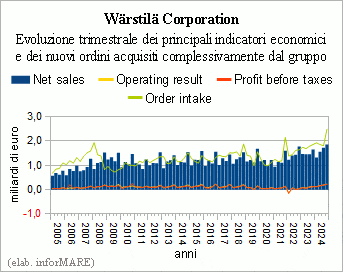
The Wärtsilä Corporation Group closed positively
the 2024 financial year both in terms of economic performance and
commercial activities, including the results achieved in the
Marine. The year ended with net sales
record of 6.45 billion euros, up +7% on 2023, with
a record contribution of over three billion from the
marine technologies (+9%). Operating profit amounted to
a record figure of 716 million euros (+78%) and a new record is
was also marked by net profit with 507 million (+89%).
In 2024, the value of new orders acquired by the group
Finnish price increased by +14% having risen to a record value
of almost €8.1 billion, of which more than €3.6 billion in the
Marine segment (+12%). The value of the group's order book
at 31 December last year it was 8.4 billion (+25%), a value never before
achieved previously, of which 3.4 billion in the Marine segment
(+21%).
 In the fourth quarter of 2024 alone, net sales
at a record value of 1.85 billion (+13%), of which 847 billion
million relating to the Marine sector (+12%). Operating profit is
profit of €229 million (+79%) and net profit of €161 million
(+68%). New orders rose by
+34% with a total of 2.5 billion euros, of which 918 million in the
marine segment (+9%).
In the fourth quarter of 2024 alone, net sales
at a record value of 1.85 billion (+13%), of which 847 billion
million relating to the Marine sector (+12%). Operating profit is
profit of €229 million (+79%) and net profit of €161 million
(+68%). New orders rose by
+34% with a total of 2.5 billion euros, of which 918 million in the
marine segment (+9%).
Commenting on the annual results and referring to the segment
Marine, the president and CEO of Wärtsilä,
Håkan Agnevall, specified that, "in the market
global traffic volumes combined with
a shift in traffic flows has led to a
significant increase in demand for ship capacity. That
combined with increasing pressure to decarbonise operations,
it has supported demand for both new construction and services. The
investments in new ships - continued Agnevall - have been
markedly higher than the levels recorded in 2023 and we have
A healthy increase in interest in fuels has been witnessed
which now account for 49% of capacity
of the ships ordered. Despite efforts to increase the
capacity and production of shipyards, especially in
China but also in South Korea, capacity utilization rates
of shipyards remain high and shipyard orderbooks
continue over time, which indicates that it still exists
a lack of capacity of the construction sites".